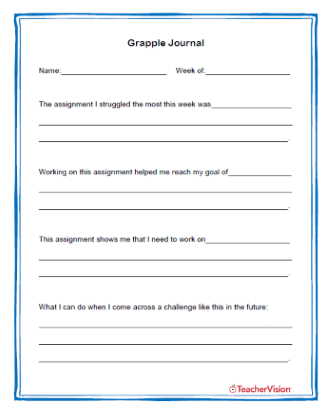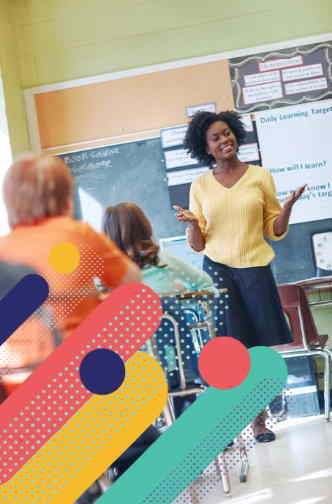The strategies in this playlist represent different activities and strategies that you can add into your existing daily routine and procedures. Each strategy is designed to provide students with an opportunity to practice perseverance, self-reflection, gratitude, and mindfulness.
Strategy Name: Grapple Journal |
|
|
|
What Is It?The Grapple Journal is a tool for students to reflect on their ability to persevere through a challenging task. Students of all ages can benefit from the exercise of reflecting on their struggles, failures, and accomplishments. Why Is It Important?As part of a growth mindset, students need to learn to persevere through challenging tasks. Taking time out to self-assess and celebrate success are important factors in gaining self-confidence. Equally as important, students need to assess their failures and see the learning in them. How Can You Make It Happen?Photocopy journal pages for students using the template. Teach students that it is important to focus on both struggles and successes. Keep the pages in a binder for students to assess growth throughout the year. When Can You Use It?The Grapple Journal can be a weekly reflection for students, or an on-the-spot tool when they have just finished a challenging task. Keep the collected journal pages for parent conferences. Ask students to share one entry per month with a group of peers. How Can You Manage It?Elementary students can keep the journals in a designated area in the classroom. Secondary students can keep the journal in their own binders or in a designated three-ring binder. How Can You Stretch Students’ Thinking?Students need to see the value in struggles and failures as well as successes. Teach students that when we overcome failures, new learning occurs, and our brains make new connections. How Can You Modify And Support Students?You can simplify or reduce the writing prompts based on student ages. You may create pre-written responses that can be circled for younger learners or those with special needs. |
Strategy Name: Gratitude Minute/Gratitude Wall |
|
|
|
What Is It?Students take time out during the day to reflect on the things for which they are most grateful. Why Is It Important?When students focus on gratitude, they automatically create a positive mindset that they can fall back on when they are faced with struggles. How Can You Make It Happen?Pick a time of day to hold the gratitude minute. In the elementary setting, it can be part of the class’s morning routine. In secondary classes, it may be better to have a weekly gratitude minute. Ask students to stand in a circle and take turns sharing things for which they are grateful. The teacher or a designated student can record the responses. When Can You Use It?You can create a scheduled time for the Gratitude Minute, or you can spontaneously ask students to pause at any time to share their thoughts. How Can You Manage It?Start a Gratitude Wall in the classroom. Older students will enjoy writing things on the wall. You can provide sticky notes or colorful pieces of paper for them. Teachers may need to write for younger students. How Can You Stretch Students’ Thinking?Students will likely copy each other’s ideas. Challenge students to think of new and different things. How Can You Modify And Support Students?Younger students may wish to draw pictures to show their gratitude. Students with special needs may dictate their ideas to an adult. |
Strategy Name: Peer Walk and Talk |
|
|
|
What Is It?Peer Walk and Talk is an exercise that helps students connect with each other and support each other in their daily struggles. Why Is It Important?Students of all ages need to build self-confidence and persistence when approaching challenging tasks. When students interact in a positive, supportive manner, they can help each other solve problems and learn from failures. How Can You Make It Happen?Ask students to stand up and take three steps. Students then stop and pair up with the nearest student. Students face each other, make direct eye contact, and greet each other. The teacher then asks one student to share what caused them the biggest challenge on the given assignment. The other student listens, gives eye contact, and responds with positive body language like head nodding. After a minute, the second student responds to what the first student shared. When Can You Use It?Peer Walk and Talk can be both a great way to give students a brain break or end a classroom activity. How Can You Manage It?Mix up the number of steps that students take for the activity. That way, they won’t always pair up with the same peers. How Can You Stretch Students’ Thinking?Explain to students that making eye contact with fellow humans raises our endorphin levels and makes us feel happier. Change up the discussion prompts so that students don’t expect the same thing every time. How Can You Modify And Support Students?Students may need prompting to stretch out and avoid speaking with the same classmates every time. Have students close their eyes and turn in a circle or simply ask them to change directions when they are walking. |
Strategy Name: Pause and Breathe (Belly Breathing) |
|
|
|
What Is It?Belly breathing is a breathing technique from yoga traditions that aids people in relaxing and re-centering. Why Is It Important?Deep breathing techniques can help kids of all ages re-center and re-assess their current situation. We all reach points of stress and frustration throughout the day. Many adults have already trained themselves to stop and take a breath when life gets overwhelming. We can help kids learn to self-regulate by practicing breathing techniques. How Can You Make It Happen?When you notice that your students have reached a point of frustration or need a break, have everyone stop for a breathing break. Ask students to stand up and reach their hands in the air as they breathe deeply in through their noses and expand their abdomens. Show them how to breathe out through their mouths as they release and lower their hands. When Can You Use It?When your students have been working on a task or project for twenty minutes or more, they may need a mental break. How Can You Manage It?Ask students to stand up and face you as you model the breathing technique. How Can You Stretch Students’ Thinking?After the students practice the breathing technique for a few repetitions, open up a discussion about their struggles and frustrations with the current task at hand. Perhaps they need an opportunity to problem-solve or simply offer each other encouragement.. How Can You Modify And Support Students?The breathing technique can be more fun for younger children if you encourage them to make noises such as roaring as they breathe out. You can use this technique with individual students when they reach a point of frustration. |







